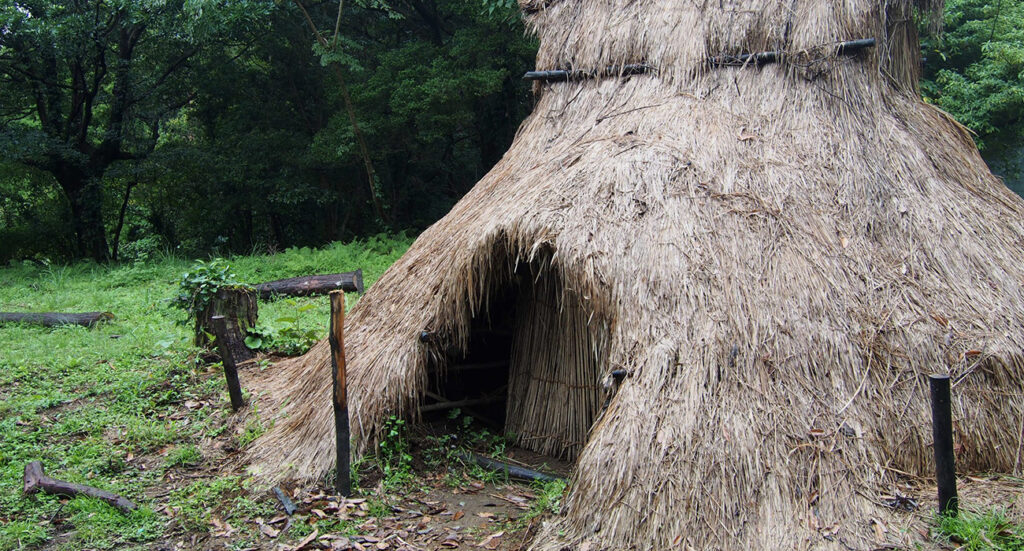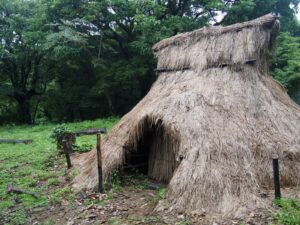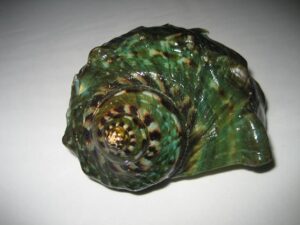THE HISTORY
PRE-MODERN
A forest that has been an object of faith since ancient times

Jomon Period
 Yakushima history dates back to around 17,000 years ago with evidence of fishing implements found in the south of Yakushima. No evidence of habitation arises until around 6,000 years ago with evidence of dwellings, ceramics and fishing implements. The reconstructed dwelling above is perhaps an example of how a dwelling may have looked. The lack of much evidence of habitation is largely due to the fact that their have been very few archeological searches on Yakushima.
Yakushima history dates back to around 17,000 years ago with evidence of fishing implements found in the south of Yakushima. No evidence of habitation arises until around 6,000 years ago with evidence of dwellings, ceramics and fishing implements. The reconstructed dwelling above is perhaps an example of how a dwelling may have looked. The lack of much evidence of habitation is largely due to the fact that their have been very few archeological searches on Yakushima.
Heian Period
 Chinese priests began arriving to Japan regularly in the 7th century. The most influential of these to visit Yakushima was Ganjin (his Chinese name was Jianzhen – 鑒真) in 753. Ganjin was on his way to Nara to ordain newly formed Buddhist temples in the Nara region (the most famous of which was the Todai-ji). Ganjin did not find Yakushima particularly appealing, but he did acknowledge that the island was abundant in natural medicines.
Chinese priests began arriving to Japan regularly in the 7th century. The most influential of these to visit Yakushima was Ganjin (his Chinese name was Jianzhen – 鑒真) in 753. Ganjin was on his way to Nara to ordain newly formed Buddhist temples in the Nara region (the most famous of which was the Todai-ji). Ganjin did not find Yakushima particularly appealing, but he did acknowledge that the island was abundant in natural medicines.
During the 9th and 10th centuries, Yakushima rose to fame as the exporter of precious shells called Yaku-gai (or Yako-gai). The Heian era (794 – 1185) aristocracy would collect them as ornaments.
Kamakura Period
Records taken at the end of the 12th century neglect to mention Yakushima, but they do include much of the neighbouring island of Tanegashima (種子島). Tanegashima was (and still is) a far more agriculturally productive island and so it is assumed that there was not much interest in Yakushima during this period due to its lack of productivity. The Kamakura Period was also when the ruling clan – the Shimazu family – took control of southern Kyushu and islands further south for the next 800 years. The Shimazu clan were an extremely powerful and influential family throughout Japanese history, but particularly leading up to the Meiji Restoration.
Sengoku Period
The tradition of pilgrimage to pay homage to the gods begins in 1488. This practise is known as `takemairi` and villagers on Yakushima continue to go to the mountains once (or in the case of some villages – twice) a year.
A few Portuguese arrived to Tanegashima in 1543 with sweet potatoes and musket guns. Potatoes became an essential addition to the national diet and guns were first put to use on Yakushima.
At the end of the Sengoku Period the ruling warlord – Hideyoshi Toyotomi – sent a huge army into Kyushu to quash the Shimazu clan who playing their usual rebellious role. After their defeat the Shimazu clan were ordered to send huge trees to Kyoto to commemorate their defeat to Toyotomi and so, for the first time, some of the large sugi trees on Yakushima were cut down. One of these trees is thought to have been the giant tree which is now where we can find Wilson Stump. However, debate continues whether this tree and others sent at the same time ever got to Kyoto.
Edo Period
The lumber industry began in the early Edo period (1603 – 1868). Yakushima was one of many areas that were heavily logged during the early Edo Period as after a few hundred years of constant warfare there was a great building frenzy around the country with many castles, temples and monuments being commissioned around this time. Prior to this era the trees near the coastal area of Yakushima were cut down for domestic use (building and firewood), but the islanders revered the large Yaku sugi trees (as well as the rivers, mountains and rocks). However, a priest and former native of Yakushima called Tomari Jochiku returned to Yakushima from his many years abroad in Kyoto, Okinawa and China. On his return Tomari persuaded the inhabitants to ‘make use’ of the abundance of lumber. Tomori declared that he had counseled with the gods and they had given him their permission to start cutting down trees. He was more likely to have counseled with the Shimazu clan who had been looking for ways to profit from the abundance of lumber on Yakushima and cash in on the building boom at the time. Hence, the lumber industry began under the control of the Shimazu clan and continued for around 350 years. Tomari was eventually considered a local ‘saint’ because he used his accumulated wealth for the benefit of the locals.
Although the Portuguese had inadvertently found themselves on the neighboring island of Tanegashima due to bad weather in 1543, contact with Europeans on Yakushima began with the arrival of an Italian missionary called Giovanni Batista Sidotti in 1708. Sidotti was a `lone-wolf` missionary and travelled to Japan under his own volition. He was taken prisoner and finally sent to Nagasaki where he befriended an influential politician/scholar named Arai Hakuseki who eventually found Sidotti a passage to Edo (Tokyo) where he continued his relationship with Arai until his premature death in 1714. Sidotti remained under house arrest until his death and he was discovered to have converted his `jailors` to Christianity. This angered the authorities (Christianity had been outlawed since the 1630`s in Japan) and Sidotti was imprisoned in the cellar of the building where he died soon after. Remains of Sidotti were found in 2014 in Tokyo.
Yakushima ‘re-appeared’ in the record books again when land surveys were taken. Yakushima was noted as having fishing and ‘mountain’ value. The ‘mountain’ value being Yaku sugi roof tiles called ‘hiragi’. Rich in resin, the hiragi are an excellent water-resistant, rot-resistant and light product. So profitable was the hiragi industry that the island’s annual stipend was paid in hiragi rather than in the usual form of rice.


